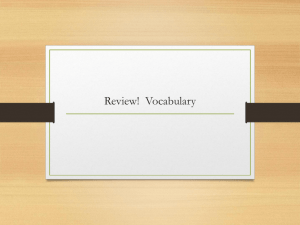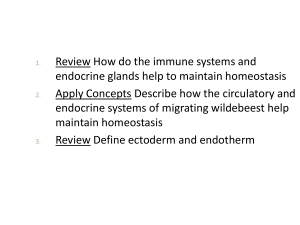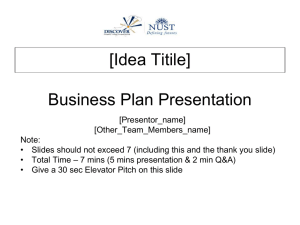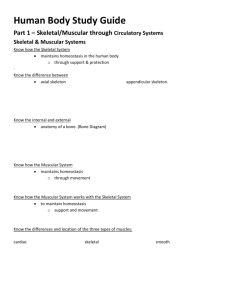SBI4U Homeostasis - Unit Plan
advertisement
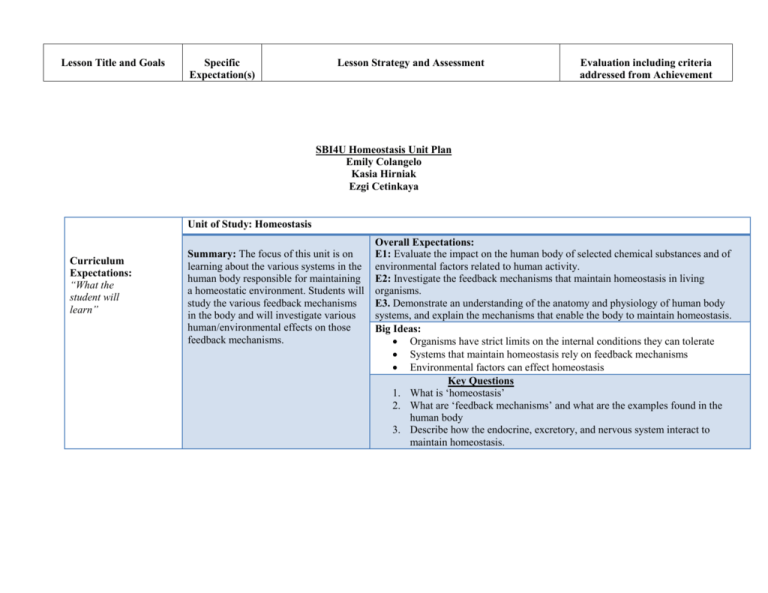
Lesson Title and Goals Specific Expectation(s) Lesson Strategy and Assessment Evaluation including criteria addressed from Achievement SBI4U Homeostasis Unit Plan Emily Colangelo Kasia Hirniak Ezgi Cetinkaya Unit of Study: Homeostasis Curriculum Expectations: “What the student will learn” Summary: The focus of this unit is on learning about the various systems in the human body responsible for maintaining a homeostatic environment. Students will study the various feedback mechanisms in the body and will investigate various human/environmental effects on those feedback mechanisms. Overall Expectations: E1: Evaluate the impact on the human body of selected chemical substances and of environmental factors related to human activity. E2: Investigate the feedback mechanisms that maintain homeostasis in living organisms. E3. Demonstrate an understanding of the anatomy and physiology of human body systems, and explain the mechanisms that enable the body to maintain homeostasis. Big Ideas: Organisms have strict limits on the internal conditions they can tolerate Systems that maintain homeostasis rely on feedback mechanisms Environmental factors can effect homeostasis Key Questions 1. What is ‘homeostasis’ 2. What are ‘feedback mechanisms’ and what are the examples found in the human body 3. Describe how the endocrine, excretory, and nervous system interact to maintain homeostasis. Chart Time Required: 75 mins E2.1 Lesson Goals: Diagnostic Test Lesson Outline Students first complete the diagnostic on homeostasis Students put into groups of 4 and try to come up with a definition for homeostasis. Then groups are paired to 8, then 12, then the whole class to create a definition for the word. Intro to “Homeostasis” Creating a definition as a class Students are put into pairs and given 11X17 paper and markers and asked to Graffiti why homeostasis is important. Then a class Graffiti is made on Bristol board which will remain displayed for the duration of the unit. Understanding the different systems associated with maintaining homeostasis Assessment Tool: Rubric to assess graffiti work Diagnostic Test to plan future lessons Criteria Addressed From Achievement Chart: Knowledge Communication Functions of the Excretory System &Intro to the Urinary System PPT Introduction of the functions of the excretory system and an overview of the urinary system Assessment: Graffiti Work Resource Textbook: McGrawHill-Ryerson Pg. 444-448 Resource: PowerPoint Presentation Time Required: 75 mins Lesson Goals: Understanding the Structure/Function of the Kidneys E 3.3 E. 3.1 Lesson Outline Students work in pairs using their text to complete the following chart FEATURE Kidney Capsule Cortex CHARACTERISTICS Thin connective tissue sheath surrounding kidney. Outer region of kidney that surrounds Assessment Tool: Chart Completion Rubric Criteria Addressed From Achievement Chart: Knowledge/Understanding medulla and contains specific nephron segments. Medulla Inner region of the kidney, surrounded by cortex, and containing specific nephron segments. Hilus Point of entry in kidney for ureter, renal artery, and renal vein. Ureter Thin walled tube, ensheathed in smooth muscle, that acts as the conduit for urine to the bladder. Renal Pelvis Cavity in center of kidney where newlyformed urine collects before entering the ureter. Nephron Functional unit of the kidney. There are ~ 1 million nephrons in each kidney that function independently of one another. Once students have completed the chart and are familiar with the anatomical terms of the kidneys, the students make notes on PPT on “Functions of the Kidneys” Assessment:The Worksheet Resources:McGrawHill-Ryerson Pg. 454 Resources: Powerpoint Presentation Time Required: 75 mins E2.1 Lesson Goals: Understanding the process of urine formation in the nephron Lesson Outline Watch Video On “The Nephron” as a class http://www.youtube.com/watch?v=glu0dzK4dbU Assessment Tool: Ticket Out the Door – To assess understanding thus far PPT. Presentation for “the nephron” Criteria Addressed From Achievement Chart: Knowledge/Understanding Communication Ticket out the Door: Students will answer simple questions about the urinary system, kidneys, and nephron. They will need to fill out questions such as “What I could use more instruction/information on is..” Assessment: Ticket out the Door (So that issues/questions can be addressed before the lab activity) Resources: Powerpoint Slides Time Required: 75 mins E2.1 E2.2 E2.3 Lesson Goals: ACTIVITY/LAB: Understanding Urine Formation in the Nephron Lesson Outline Anatomy Colouring/Labeling Lab Activity for the Nephron (30 min) Assessment Tool: Rubric based on completion of Nephron activity Lab Handout Based on Questions 52-57 P.475 McGraw-Hill Test (In groups of 3) (30 min) Criteria Addressed From Achievement Chart: Knowledge/Understanding Thinking & Inquiry Assessment: Lab activity/Handout on the Nephron Resources: Lab Handouts Time Required: 75 mins E1.1 E1.2 Lesson Outline Diseases of the Excretory System PPT Presentation Assessment Tool: Worksheet Peer-Assessment Jigsaw Activity: • Gout • Kidney stones • Urinary Tract Infections (UTI) • Diabetes insipidus • Liddle’s syndrome Lesson Goals: Identifying and Understanding Functions & Disorders of the Excretory System Criteria Addressed From Achievement Chart: Knowledge/Understanding Communication Thinking/Inquiry 5 People to a groupeach get a condition for their handout, go to their expert groups, research using the text and the internet to fill out worksheet. Students then go back to their original group and share the info with the other four group members. Assessment: Worksheet Peer Assessment Time Required: 75 mins Lesson Goals: Case Study : How the body could maintain homeostasis for 15 days without food/water. True Story From Port Au Prince, Haiti E3.3 Lesson Outline In teacher selected homogeneous groups of 3, students are to work through an online case study about homeostasis. The case study examines a 15-year old who survived for 15 days with no food and water. Website: http://sciencecases.lib.buffalo.edu/cs/collection/detail.asp?case_id =559&id=559 Assessment: Completed Lab Peer Assessment Teacher Observation Assessment Accommodations:For the lower level homogeneous groups, I will assist as needed, and other groups that complete the activity will act as peer tutors. Assessment Tool: Completed Lab (Rubric) Peer Assessment (Rating Scale) Teacher Observation Assessment (Rating Scale) Criteria Addressed From Achievement Chart: Knowledge/Understanding Thinking/Inquiry Communication Introduction What is the importance of the endocrine system? E3.1 Time Required: 75 mins Lesson Goals -overview of the endocrine system anatomy (endocrine glands) -two types of endocrine organs- primary and secondary) Lesson Outline Half of the students are given names of the endocrine organs and half of the students are given the corresponding definitions. Using the resources provided to them (textbook, diagrams etc that will be provided for them) they will have to find their corresponding pairs. A big diagram will be posted at the front of the class, students will be required to label the diagram appropriately with their definitions and present to rest of the class. Discussion will follow with teacher. Assessment: Student research skills in finding their corresponding definition partners, diagram labeling at the front Assessment Tool -Anecdotal notes, observation of student progress -Appropriate label and definition on diagram (rubric) Criteria addresses from Achievement Chart -Labeling and definitions (Knowledge and Understanding, communication) -Mini-presentation (communication) Accommodation: Provide different types of worksheets on the basic anatomy of endocrine system depending on the group of learners in the classroom The Primary Endocrine Organs E3.1 E3.3 Time Required: 75 mins Lesson Goals -anatomy and physiology of hypothalamus and pituitary gland, pineal, thyroid and parathyroid, adrenal glands, thymus, pancreas and gonads The Primary Endocrine System E3.1 Lesson Outline Students will be given out diagrams of various parts of the primary endocrine glands. As a class, go through part and have students label their diagrams appropriately. Have them create a concept map of their own clearly showing the relations of each of the parts of the primary endocrine system to each other. Assessment Tool Rubrics and anecdotal notes -observation during class discussion of student feedback -diagrams -concept map Assessment Completion of diagrams and concept map Criteria addressed from Achievement Chart -Knowledge and understanding, Communication- discussion, diagrams, concept map Accommodation: Keep in mind that students should be able to explore their creativity in their concept maps. They can be encouraged to write out summaries or even pictures of their own depending on their learning style Lesson Outline Assessment Tool : importance of homeostasis E3.3 Time Required: 75 mins Lesson Goals -importance of homeostasis in endocrine system -negative feedback loops Divide students into groups of four and present them with different case studies regarding the feedback loops affecting hypothalamic and anterior pituitary tropic hormones as well as thyroid hormone release. Have them research (on computer or in their biology textbook) the ways in which the loop works. They are to create one as a group and present their understanding o f the loop to the class. They should hand in their diagrams and summary of the way the feedback works at the end of the lesson. Assessment -negative feedback loops -presentation -summary of the way the feedback works The Secondary Endocrine Organs Time Required: 75 mins Lesson Goals -anatomy and physiology of endocrine system- heart, kidneys, GI tract, stomach, small intestine, liver -importance of homeostasis in endocrine system E3.1 E3.3 Accommodation Provide more problematic and variety of cases to the enriched students and make sure to provide clear and easy to understand resources for those students who may struggle in their understanding of the feedback loops. Lesson Outline Present students with the following video to review what they have already studied and to lead them into study of secondary endocrine organs. Students are given out a hand out to fill in as they go through it. http://www.youtube.com/watch?v=NINaidIdt4M In groups of four, assign various roles to students and have them (as a group) create a table for the secondary organs with their respective hormones and functions. Assessment -question handouts -group tables Accommodations Rubrics and anecdotal notes -negative feedback loop diagrams -summaries -presentation Criteria addressed from Achievement Chart -Knowledge and Understanding, Communication: negative feedback loops created, summaries, presentation Thinking/Investigationnegative feedback loops created, summaries Assessment Tool Rating scale -handout of questions -tables created Criteria addressed from Achievement Chart -Knowledge and Understandinghandout, table/chart Communication-table/chart Thinking and Investigation- certain question on handout (relation of hormones) Application-certain questions on handout (diseases caused in relation Hormones: importance of homeostasis E3.1 E3.3 Time Required: 75 mins Lesson Goals -hormone interactions -negative feedback loops Students should be able to be creative with their tables. Encourage visual learners to draw diagrams for example in their tables if they need be. to breakdown of endocrine system) Lesson Outline Present students with an article on pituitary adenomas. After reading it, have them brainstorm all the ways in which hormonal imbalance is caused as to cause pituitary adenomas. Students are then required to connect this to the many feedback loops learned. Have them investigate in groups and present the breakdown of the endocrine systems in relation to this disease in front of the class. http://www.irsa.org/pituitary_tumors.html Assessment Tool Anecdotal notes and rating scale on their brainstorming, presentation and findings presented Assessment -brainstorming points -presentation with feedback loops and findings in relation to pituitary adenomas Accommodations Students should be able to be creative in the way they communicate their findings to the class depending on their learning styles, strengths and weaknesses. Provide a simpler summary of the article or a more specific article depending on level of student. Clinical Connections Activity Time Required: 75 mins Lesson Goals -Endocrine system regulation of energy metabolism and growth E3.3 Lesson Outline This activity will take two classes. Students will be assigned into groups of four (more or less depending on specific group of students). They are to pretend they are doctors. They will be presented with various patients. They are to research what these patients have and diagnose the patient and provide solutions as see fit. They will however have to clearly explain to their patients what exactly is going wrong. They will present their summaries Criteria addressed from Achievement Chart Knowledge and Understandingbrainstorming Communication- presentation Thinking/Investigation-brainstorming, creating feedback loops and corresponding explanations Application- presentation results in relation to pituitary adenomas Assessment Tool -Rubric for research reports, presentation -Anecdotal notes for student progress and feedback throughout, their research skills Criteria addressed from -clinical connections -feedback loops (speech to patients) with appropriate diagrams and feedback loops to their class as doctors presenting their diagnoses to their patients next class Assessment -explanation summary/research report -diagrams of feedback loops Achievement Chart Both the research report and presentation covers all criteria on chart- knowledge and understanding, thinking/investigation, communication, application Accommodation Allow students to present their findings in different ways depending on the learning styles The Importance of the Nervous System Time Required: 75 mins Lesson Goals: -To understand the organization of the nervous system -To learn the anatomy of a nerve cell -To understand the basics of a neural circuit E3.1 E2.1 Lesson Outline -Students engage in a Jigsaw Activity wherein the class is divided into 4 home groups by assigning a number 1 to 4 to each group member. - Teacher assigns Expert group topics as follows: Group #1 Topic: Organization of the Nervous System, Group #2 Topic: Anatomy of a Neuron, Group #3 Topic: Three main types of Neurons and their function, Group#4 Topic: Reflex Arc/Knee jerk reflex. - Teacher distributes worksheets prepared on each topic to be completed by each expert group member. - Students are reunited with their home group members with whom they create a concept map summarizing the organization of the nervous system. Assessment: -Worksheets -A concept map Accommodation: Provide students with Post-it notes for concept Assessment Tool: -Rating Scale to assess worksheet -Rubric to assess concept map Criteria Addressed from Achievement Chart: -Knowledge (worksheet) -Communication (concept map drawn) -Knowledge (correct placement of components in the concept map) map Resource Textbook: Nelson Science, 9.1 p.412-417 The Nervous System: Nerve Impulse/Synaptic Transmission Time Required: 75 mins Lesson Goals: -To learn how nerve signals are propagated along neurons - To learn how nerve messages are send from one neuron to the next -To learn how nerves affect tissues like muscles E3.1 Lesson Outline -Students are shown a PowerPoint presentation covering the following concepts: 1. action potential and key stages: depolarization, repolarization and refractory period 2. Threshold levels and the All-or-None response 3. Synaptic Transmission -Teacher shows the following videos: Neuron Action potential and propagation http://www.youtube.com/watch?v=xxl-Ysm8LiA The Synapse http://www.youtube.com/watch?v=PGqtwoGJUxw&feature=relat ed - Students are divided into 6 groups. Teacher assigns each group with one topic from the following: action potential propagation, threshold levels and the All-or-None response, and Synaptic Transmission. - All six groups prepare flow charts summarizing the key points or stages on the assigned topics. - Each group then presents their flow chart in oral classroom presentations. Assessment: - Flow chart - Class oral presentation Assessment Tool: -Rating Scale to assess oral presentations, and flow chart. Criteria Addressed from Achievement Chart: -Thinking/Investigation (Oral Presentation and flow chart) The Nervous System: Central Nervous System E3.1 Time Required: 75 mins Lesson Goals: -To learn about the anatomy and function of the central nervous system Lesson Outline -Using their Nelson Science textbook pgs. 427-430 students engage in independent reading about the CNS. - Students then partner up with another student and create flash cards to help learn vocabulary, structure, and functions. -Using the flash cards students quiz each other on the knowledge of the anatomy and function of key CNS structures. -Students read Case study “A One-Two to the Brain” published in Discover magazine http://discovermagazine.com/1994/nov/aonetwotothebrai451/?sear chterm=Central%20Nervous%20system and complete questions and a case study reflection. Assessment Tool: -Rubric to assess case study reflection and questions Criteria Addressed from Achievement Chart: -Application (Case Study Reflection and Questions) Assessment: -Students write a quiz on the anatomy and functions of the CNS -Case Study reflection and questions Resource Textbook: Nelson Science, p.427-430 The Nervous System: Autonomic Nervous System Time Required: 75 mins Lesson Goals: -To learn about the autonomic nervous system E3.1 Lesson Outline - Students complete a Nervous System KWL chart. - Prior to watching two videos they will complete the K: What do I KNOW about this topic already? - Students are asked to take notes throughout the videos: http://www.youtube.com/watch?v=HmV2xGpBCMs&feature=rel ated http://www.youtube.com/watch?v=JvuugFKe1PE&feature=relate d - Students complete the W: What did I learn WHILE watching the videos. - Teacher leads a general discussion about the autonomic nervous system, and about the videos watched. Assessment Tool: -Anecdotal record of students’ understanding of autonomic nervous system through KWL chart -Rating scale for self-assessment Criteria Addressed from Achievement Chart: -Knowledge (KWL chart) -Knowledge (self-assessment) - Students engage in a Think-Pair-Share activity during which the teacher poses a question, allows students to think and then share their answers with a partner next to them and then the answers are shared with the whole class. - Students complete the L: What have I LEARNED today. The Nervous System: Special Senses E3.1 Time Required: 150 mins Lesson Goals: -To review anatomy and physiology of the eye and ear Assessment: -KWL chart to check students’ understanding of lesson concepts -Student self-assessment of understanding of the nervous system Lesson Outline Part I - Students are introduced to the Special Senses by watching a dissection of the cow’s eye: http://www.exploratorium.edu/learning_studio/cow_eye/step01.ht ml - Teacher sets up different stations around the class with various activities about the anatomy and physiology of the eye and ear. Each station provides resources and worksheets to help students complete the activities. Part II -Students work in groups and perform the dissection of the cow’s eye. -Students will draw a labeled diagram showing the anatomy of the eye The Nervous System: Effect of Drugs on the Nervous System E1.1 Assessment: - Activity worksheets - Anatomy of the eye and ear Bell ringer (to be completed at the end of the unit) Lesson Outline - Students go to the school library - Each student is assigned with a specific drug, they conduct Assessment Tool: -Rating scale to assess bell ringer anatomy quiz. - Rating scare to assess worksheets. Criteria Addressed from Achievement Chart: -Knowledge (bell-ringer, worksheets) Assessment Tool: -Rubric to assess Research Report Time Required: 150 mins Lesson Goals: -To research the effects of various drugs on the nervous system - To examine a case study about the effects on the human body of taking chemical substances to enhance performance or improve health Bell Ringer Activity Time Required: 75 mins Culminating Task Time Required: 225 mins Unit Test Time Required: 75 mins research on the effects of this drug on the human nervous system - Students write a research report summarizing their findings Assessment: - Research report Anatomy of the eye and the ear. Criteria Addressed from Achievement Chart: -Thinking/Investigation (Research Report)


